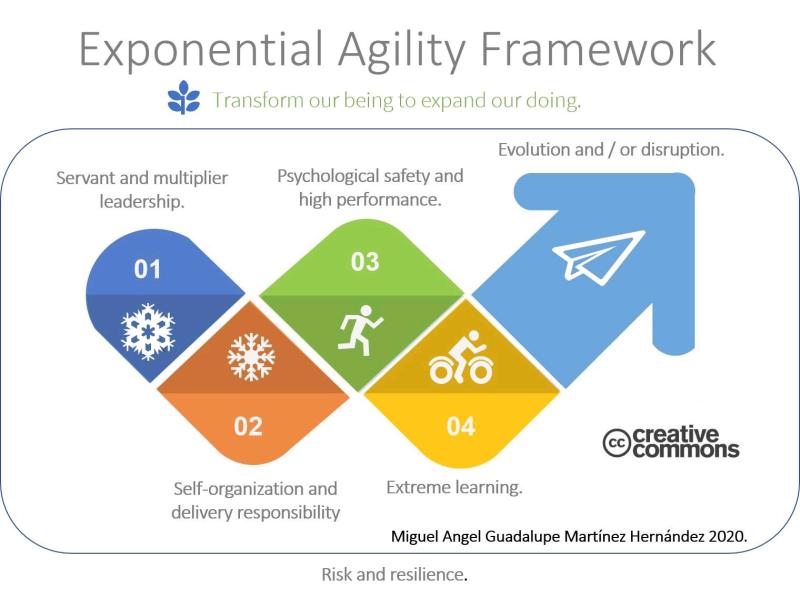1. Servant and multiplier leadership.
Where the main objective is to leverage the transformation, lead yourself first to lead others, govern through an organization different from the traditional-western way.
2. Self-organization, autonomy, delivery and responsibility.
It consists of ensuring the delivery of value continuously and emergently, through autonomy and responsibility, to guarantee the delivery of results, remember that the stronger the self-organization capacity of an organizational system, the stronger the system’s capacity to Learn, create and maintain new functions.
3. Psychological Security and High Performance.
It consists of creating and maintaining a high-performance work ecosystem, working first on ourselves, to teach this resilience to our team and establish it in our ecosystem.
4. Extreme learning.
Learn to unlearn, learn to undertake, learn to learn, our learning is the basis of our being, it is continuous, emerging and never ends, we must learn to be effective and disciplined to acquire and get rid of habits, so that we reflect this in our interactions and attitudes towards others.
5. Risk and resilience.
Manage risks to embrace innovation, extend our capabilities realistically, incrementally and responsibly, experimentally overexpose calculated mitigations to expand our risk threshold and increase our capabilities, teaching this to our teams and establishing meta-criteria that foster growth and development in this sense.
6. Evolution and / or disruption.
It lies in disrupting ourselves, to know deeply the science of disruption, so that we know how to find new markets and differentiate ourselves at all times.
I only have questions that left intentionally.
• Is performing an agile transformation a very personal challenge, does it require jumping on oneself, regardless of the role we play?
• Does it require commitment, an agile personal transformation manifesto, a strategy, a tactic and a personal agile transformation backlog?
Miguel A. Martínez H.
Bibliography:
- Linkedin (2019). Psychological Security on Building Agile Ecosystems. San Francisco, CA. Recover from https://www.linkedin.com/pulse/psychological-security-building-agile-ecosystems-mart%C3%ADnez-hern%C3%A1ndez/
- Linkedin. Resilience as Leader (2019). San Francisco, CA. Recover from “https://www.linkedin.com/learning/building-resilience-as-a-leader”.
- OpenExo (2019). Exo Consultant Certification Program. Recover from https://www.openexo.com/certifications/#path-section
- Edmondson, A. C. (2018). The Fearless Organization: Creating Psychological Safety in the Workplace for Learning, Innovation, and Growth. New York, USA: Wiley.
- Edmondson, A. C., Harvey, J. F., & Chesbrough, H. W. (2017). Extreme Teaming: Lessons in Complex, Cross-Sector Leadership. Wagon lane, UK: Emerald Publishing Limited.
- Giannantonio, C. M., & Hurley-Hanson, A. E. (2015). Extreme Leadership: Leaders, Teams and Situations Outside the Norm. MA, USA: Edward Elgar Publishing.
- Johansen, B. (2017). The New Leadership Literacies: Thriving in a Future of Extreme Disruption and Distributed Everything. California, USA: Berrett-Koehler Publishers, Incorporated.
- Johnson, W. (2019). Disrupt Yourself: Master Relentless Change and Speed Up Your Learning Curve. California, USA: Harvard Business Review Press.
- Josephs, A., & Rubenstein, B. (2018). Risk Up Front: Managing Projects in a Complex World. CA, USA: Lioncrest Publishing.
- Kaufman, J. (2014). The First 20 Hours: How to Learn Anything … Fast. New York, USA: Penguin Publishing Group.
- Koestenbaum, P. (1991). Leadership: The Inner Side of Greatness. California, USA: Wiley.
- Koestenbaum, P., & Block, P. (2001). Freedom and Accountability at Work: Applying Philosophic Insight to the Real World. CA, USA: Wiley.
- Radecki, D., Ancona, C., Hull, L., McCusker, J., & The Academy of Brain-based Leadership. (2018). Psychological Safety: The Key to Happy, High-performing People and Teams. NY, USA: ABL.
- Schmidt, E., Rosenberg, J., & Eagle, A. (2019). Trillion Dollar Coach: The Leadership Playbook of Silicon Valley’s Bill Campbell. California, USA: HarperCollins.
- Wagner, D., & Disparte, D. (2016a). Global Risk Agility and Decision Making: Organizational Resilience in the Era of Man-Made Risk. NY, USA: Palgrave Macmillan UK.
